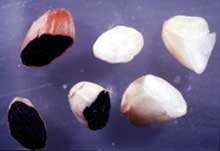Articles and reports from the Life Sciences and chemistry area deal with applied and basic research into modern biology, chemistry and human medicine.
Valuable information can be found on a range of life sciences fields including bacteriology, biochemistry, bionics, bioinformatics, biophysics, biotechnology, genetics, geobotany, human biology, marine biology, microbiology, molecular biology, cellular biology, zoology, bioinorganic chemistry, microchemistry and environmental chemistry.

Caterpillar study shows order in the complexity of tropical biodiversity
One of the world’s largest and highest-quality set of observations on live tropical insects and their host plants has led researchers to reinterpret the structure of tropical insect communities. The team of scientists who collaborated on this analysis includes Scott Miller of the Smithsonian’s National Museum of Natural History, Yves Basset of the Smithsonian Tropical Research Institute, Vojtech Novotny

A team of experts has refuted previous findings published last summer stating that Pfiesteria is not toxic to fish or humans. When they cultured the same strain of P. shumwayae studied by the dissenting scientists, it produced a toxin that killed fish within minutes.
Dr. JoAnn Burkholder, director of North Carolina State University’s Center for Applied Aquatic Ecology, presented the results of the new study Tuesday at the 10th International Conference on Harmful Algae in S

A high-throughput assay developed by University of Illinois at Chicago chemists has led to discovery of a small organic compound that shows the unusual ability to inhibit cell migration. The new compound, identified as UIC-1005, may play a role in developing new kinds of cancer drugs.
The findings are published in the November issue of the journal ChemBioChem.
“We’ve been looking for chemical compounds that slow the process of cell migration,” said Gabriel Fenteany, assistant

UCLA Neuropsychiatric Institute researchers have localized a region on chromosome 16 that is likely to contain a risk gene for Attention Deficit Hyperactivity Disorder, the most prevalent childhood-onset psychiatric disorder.
Their research, published in the October edition of the American Journal of Human Genetics, suggests that the suspected risk gene may contribute as much as 30 percent of the underlying genetic cause of ADHD and may also be involved in a separate childhood onset disorder

A study by two North Carolina State University geneticists traces the origin and evolution of a genetic mutation that long ago led to the creation of a type of rice known as glutinous, or “sticky,” rice.
The molecular genetic research leads researchers to believe that glutinous rice – which differs from non-glutinous, or common, rice on account of a mutation in its Waxy gene that suppresses the formation of a starch called amylose – most likely originated a single time in Southeast Asia. Fu

Researchers have developed a new way to use a decade-old imaging method to directly compare the brains of monkeys with those of humans. Their report appeared in the journal Science.
The method uses functional Magnetic Resonance Imaging (fMRI) – a technique that measures blood volume and flow and blood-oxygen levels in the brain. It also provides an indirect measure of neuronal activity in different regions of the brain.
Neurons need oxygen and glucose to work. Blood carries